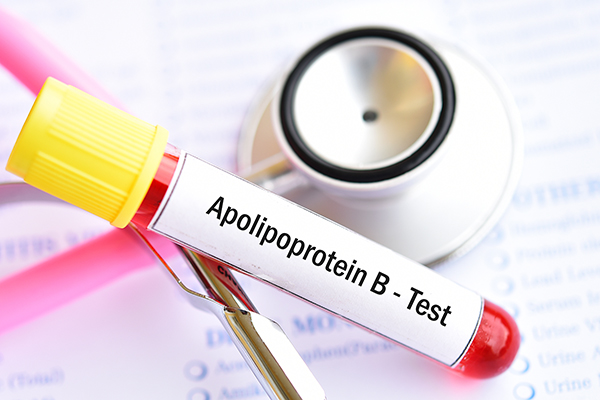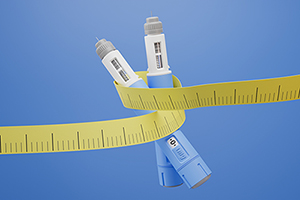



| By Dr. Ronald Hoffman

It’s the Next Big Thing in cardiovascular prevention. Apolipoprotein B-100, or ApoB for short, may supplant cholesterol, HDL, LDL, and triglycerides as a more reliable way of predicting risk of heart disease and stroke; it also might also be a promising target for intensive lowering. (Cue the drug reps!)
The problem is that total cholesterol is a poor discriminator of heart risk; even high levels of HDL, usually protective, are not always a get-out-of-jail card. LDL is the current standard for determining whether statin therapy is advantageous, but LDL quality—the size of its particles—governs its atherogenicity.
Enter ApoB. It’s a protein that carries fat molecules, including LDL cholesterol – the so-called “bad cholesterol” – around the body. It’s also a transporter for harmful Lp(a) and chylomicrons that package triglycerides. Studies now suggest that it’s not so much total cholesterol, but the chief carrier protein for the most dangerous kind of LDL and other bad actors—ApoB—that determines susceptibility.
ApoB usually tracks with overall cholesterol and LDL, especially the small dense kind, but occasionally it signals outsize risk in the presence of seemingly reassuring cholesterol numbers.
High ApoB is in part an inherited trait, but it’s also associated with metabolic syndrome which has a lot to do with diet and exercise. Therefore, it’s partly merit-based; but the best lifestyle efforts of some fail to bring in within optimal ranges.
So, in addition to being a warning sign, ApoB has become a target for pharmaceutical intervention. Statin drugs lower it; new pricey PCSK9 drugs knock it down even further.
The cut-off for high ApoB is generally thought to be 130; but even levels above 100 are acknowledged to be associated with cardiovascular events. People in their 20s average an ApoB around 90, but it increases with age, and to a more rapid extent in males. A typical 60-year-old is likely to have an ApoB of 120.
Peter Attia MD, host of the popular podcast The Drive, has been one of the most enthusiastic advocates for routine ApoB screening. Additionally, he’s staked a claim to a more audacious proposition:
“If you pharmacologically lower ApoB to somewhere in the 20 to 30 milligram per deciliter range for everybody in the population while someone is in their 20s, can you eliminate ASCVD? I think the answer is probably yes.”
His buy-in is evidenced by his aggressive use of statin drugs, Zetia, and PCSK9 inhibitors in his private practice to lower his patients below what he considers the optimal zone: 60, or even far less. He claims the sooner ApoB lowering is initiated—preferably by age 40—the more comprehensive the protection.
Attia recounts that, despite a relatively minimal coronary plaque score of 7 at age 50, he takes a cholesterol-lowering drug “stack” to get his LDL below 30, and “obliterate” his ApoB. He says:
“We have lots of tools up our sleeve today more than ever before and that’s why I just think we should be more and more aggressive on this now.”
His recommendations outpace even the most zealous guidelines of mainstream cardiology which say, “Emerging data show that intensive lipid-lowering therapy produce larger absolute risk reduction in patients with polyvascular disease, post coronary artery bypass graft and diabetes,” but caution that “residual cardiovascular risk is recognised even after achieving low LDL” and urge restraint because “unselective implementation of PCSK9 inhibitors is undesirable and unaffordable given the modest effect on preventing cardiovascular events at a significant increase of health costs.”
Mainstream docs argue for selective application of intensive lipid-lowering only for patients deemed at high risk for cardiovascular events.
Those PCSK9 drugs require weekly injections and cost over $12,000 a year; their widespread use is estimated to incur an increase in healthcare costs of $315,000 to $450,000 per QALY (quality-adjusted life years), a measure of how effective medical interventions are at improving health and life span. For example, if a person lives in perfect health for one year, that person will have 1 QALY. Imagine the scope of the problem when we’re striving to deliver more QALYs to tens of millions of at-risk Americans!
Cost may not be a consideration in Attia’s concierge practice, but there are other reasons to question aggressive universal ApoB-lowering. One is that other risk factors, unaddressed by decimating LDL, may perpetuate cardio risk. These include overweight, sedentary lifestyle, elevated blood sugar and blood pressure, high uric acid, high homocysteine and Lp(a), and above all—inflammation.
A recent article by Paul Ridker MD—known for his pioneering work on high-sensitivity C-reactive protein (hs-CRP) as a cardiovascular risk factor—demonstrates that, even when LDL is lowered with lipid medications, heart attack and stroke risk remain if inflammation is unaddressed.
He demonstrates this in a new meta-analysis which shows that hs-CRP is more predictive of future cardiovascular events than LDL in statin-treated patients. In other words, regardless of how low you go with LDL or related ApoB, a persistent high level of inflammation will thwart efforts to fend off vessel disease.
There are natural ways to address hs-CRP; see my article here.
The other problem is that many patients with high LDL or ApoB will not be beneficiaries of lipid lowering. As I’ve been saying forever, therapy should be applied discriminately, based on the presence—or absence—of arterial plaque. This can easily be ascertained with a CT heart scan or MRI angiogram, which establishes a calcium score; to rule out incipient cerebrovascular disease that leads to strokes, carotid ultrasound is definitive.
This view is vindicated by recent studies. One found that:
“ . . . absence of coronary artery calcium (CAC) and noncalcified plaque was a prevalent finding among those with severely elevated LDL-C levels. Across the LDL-C spectrum, absence of CAC was associated with low rates of atherosclerotic cardiovascular disease and death, with increasing rates in patients with greater CAC burden.”
Another demonstrated that, “Absence of CAC may help ‘de-risk’ individuals in this high-risk patient population” even in patients with LDL cholesterol 190 or greater. Moreover, inconsistent with the Cholesterol Hypothesis, the researchers “observed absence of plaque in 46.2% of patients with LDL-C levels of at least 190 mg/dL.” (!)
When it comes to diet, while high saturated fat diets can raise LDL and ApoB, a study shows that:
“Substituting protein for carbohydrate in the context of a healthy dietary pattern reduced atherogenic LDL, resulting in the most favorable profile of ApoB lipoproteins.”
This has emboldened some low-carb acolytes to make the sweeping—and in my opinion exaggerated—assertion that, “Statin therapy is not warranted for a person with high LDL cholesterol on a low-carbohydrate diet”. Nonetheless, low-carb diets can go a long way towards obviating cardiovascular risk.
I’ll conclude with an example from my practice. A 69-year-old woman consulted me for a second opinion on whether she should assent to statin therapy prescribed by her primary care physician. Her labs were as follows:
Cholesterol: 234
HDL: 72
LDL: 157 (Higher than the 130 threshold considered a red flag for cardio risk)
ApoB: 114 (Well above what would prompt some doctors to prescribe cholesterol drugs)
She was of normal weight, exercised moderately, never smoked, ate a healthy low-carb diet (evinced by her low triglycerides of 35) and had normal blood sugar and blood pressure.
At my urging, she underwent non-invasive imaging tests:
Her coronary calcium score was . . . ZERO! Her carotid Doppler showed NO evidence of atherosclerotic plaque!
It could be argued that a healthy 69-year-old woman might have up to three additional decades of life to develop cardiovascular disease, but this is extremely unlikely, and taking medication as a hedge against that unlikely eventuality would have negligible benefits. If she were 29, that medication-as-prophylaxis line of reasoning might carry more weight—if at all.
I advised her to forego cholesterol meds and maintain her healthy lifestyle, with some additional tweaks. She was reassured.
BOTTOM LINE: ApoB is worth checking, and sometimes treating, but it’s just one element in a comprehensive personalized cardiovascular risk assessment.
Though we think of declining estrogen as the hallmark of menopause, it's actually common for…

Up to 12 percent of Americans have ulcers at some point in life. Peptic ulcers…
Gallbladder disease is a modern illness. An estimated 20 million Americans have gallbladder disease. The…

Dr. Antonio Bianco, recipient of the American Thyroid Association’s John B. Stanbury Thyroid Pathophysiology Medal,…

There’s a misconception among low-carb dieters. Many people believe a low-carb diet is much higher…

New, more powerful weight loss drugs: Drugs like Wegovy, Rybelsus, Ozempic and Mounjaro/Zepbound are revolutionizing…

Leyla Weighs In: Eating for Energy and Emotional Well-Being

Our virtual voicemail is open 24/7, so there's no need to wait to submit your questions for Dr. Hoffman. Leave a message, and you may hear your question featured on the Intelligent Medicine radio program!